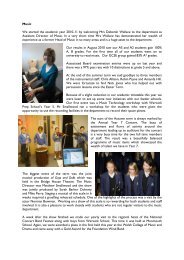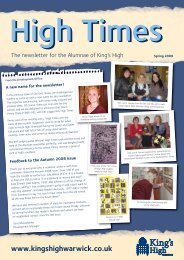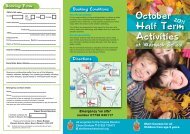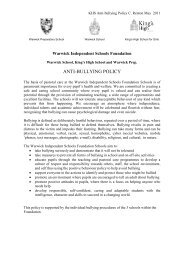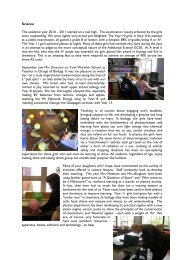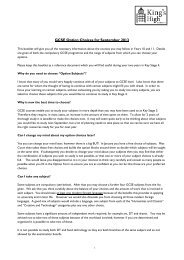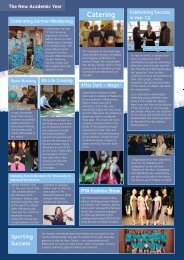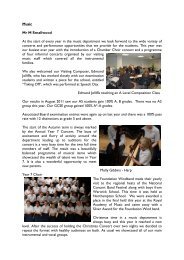Fire Policy - King's High
Fire Policy - King's High
Fire Policy - King's High
Create successful ePaper yourself
Turn your PDF publications into a flip-book with our unique Google optimized e-Paper software.
Information about <strong>Fire</strong> Warning System<br />
• The <strong>Fire</strong> Alarm System is connected to a monitoring station which directly notifies<br />
the Emergency Services between the hours of 2000 and 0700.<br />
• During all other hours emergency response will not be received until the school<br />
notifies the emergency services that there is actually a fire or other emergency.<br />
• The System panels are located in the office, the Sixth Form foyer and the CAC<br />
foyer.<br />
• The alarm is a continuous siren.<br />
• Smoke and heat detectors are located in vulnerable areas.<br />
• Break glass call points are located at various locations.<br />
• An independent contractor inspects the fire extinguishers and fire alarm annually<br />
and records results in the <strong>Fire</strong> Precautions Manual located in the Domestic<br />
Services Manager’s office. Emergency lighting is inspected every six months by<br />
an independent contractor and the results are recorded in the <strong>Fire</strong> Precautions<br />
Manual.<br />
• The fire alarm is tested weekly on a Friday afternoon at 5pm. The siren will sound<br />
for approx. 10 seconds and this test will be recorded in the <strong>Fire</strong> Precautions<br />
Manual. If the siren sounds for more than 30 seconds then it should be assumed<br />
that it is not a test and evacuation should commence.<br />
Action to be taken by a person discovering a fire<br />
In the event of discovering a fire, raise the alarm immediately using the nearest break<br />
glass call point; begin evacuation to assembly area immediately. Do not attempt to<br />
tackle the fire unless you have been trained to do so. Leave the building using the<br />
nearest exit and report to assembly point.<br />
Evacuation procedures<br />
• Evacuation must begin as soon as the alarm is heard.<br />
• All personal belongings should be left.<br />
• Evacuation should be from the closest and safest escape route.<br />
• Staff should check all surrounding rooms/ toilets etc en-route where appropriate.<br />
• Ensure the door is closed behind you.<br />
• Ensure all gas, electrical and hazardous machinery is isolated if safe to do so.<br />
• Any member of staff or pupil who has been identified as being particularly at risk<br />
will have a Personal Emergency Evacuation Plan (PEEP) completed for them<br />
and a “buddy” will be identified to assist them in the event of an evacuation. The<br />
following areas have Evac chairs, St Mary’s and St Nic’s and a number of staff in<br />
each of these areas are trained in the use. A timetable for anyone who has a<br />
PEEP will be kept in the School Office.<br />
• All visitors must sign in and will be accounted for by Geraldine Brown. In the<br />
unlikely event that a visitor is unaccompanied then the information contained in<br />
the “Health & Safety Information for Visitors” booklet adjacent to the signing in<br />
book will provide them with adequate information to assist their evacuation.<br />
Young people will be allocated a mentor who will address all Health and Safety<br />
matters with them and discuss such things as evacuation procedures, fire alarms<br />
and assembly points.<br />
• Any staff who are lone working should make themselves familiar with the<br />
environment and be aware of the location of the fire exits, call points and<br />
assembly points. Anyone lone working must ensure that people know they are<br />
lone working. All staff who lone work should still sign in at the School Office.<br />
KHS <strong>Fire</strong> Action <strong>Policy</strong> November 2011 Page 6





